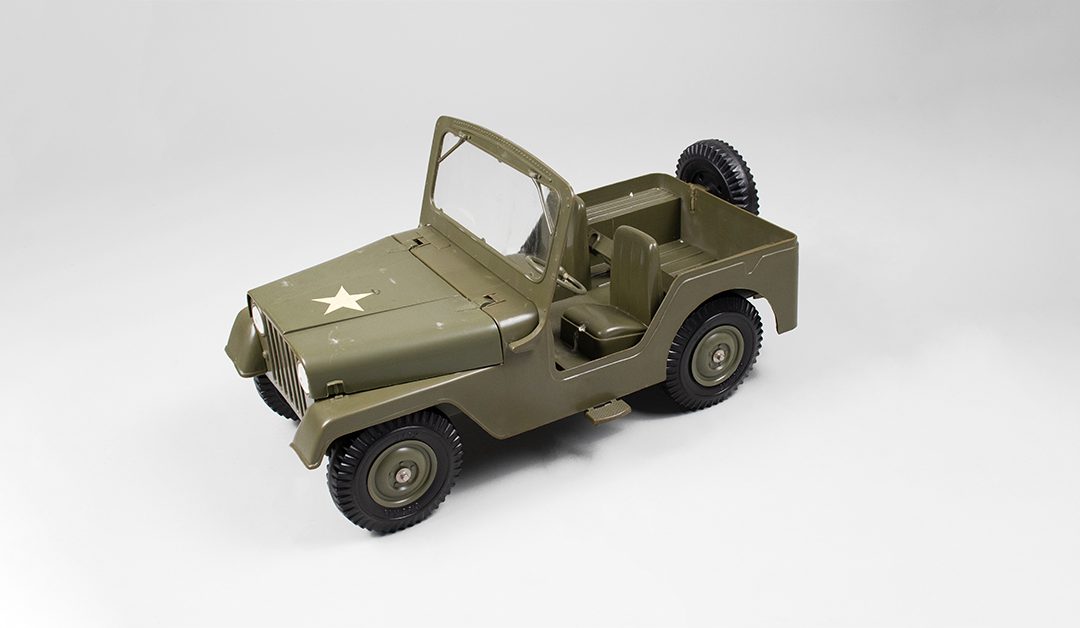
(25/25)
After a whole year of highlighting never-before-seen artifacts from within our collections in honour of the Diefenbunker’s 25th anniversary, today, we are featuring the last one of this milestone year! What better artifact to conclude this series and symbolize our travels through Cold War history and across the continent than a Marx toy jeep along with its original packaging.

Jeep loaned from the Canadian War Museum, formally on display at the Diefenbunker.
The term “jeep” was originally coined in the 1940s as slang that was used amongst members of the U.S. Army to mean “new recruits” or “vehicles.” After the Army put forward a request during World War II for a general-purpose vehicle that was small, lightweight, had four-wheel drive for cross-country travel, and could carry a light machine gun, the term “jeep” took on a physical form and ultimately became a hero to thousands of Allied soldiers around the world. After outsourcing several manufactures to bring this idea to fruition, only two companies provided vehicles that met the requirements: the Bantam Reconnaissance Command and Willys-Overland. Ford later entered the scene for further testing and development of these wartime vehicles and as a result, a total of 647,925 jeeps were built between 1940 and 1945.
One model of particular importance that followed this period of mass production was the M38A1. Developed in 1952, the M38A1 became known as the most all-around military jeep known for its improved comfort and safety compared to its predecessors. Given this, toy renditions of this vehicle became popular thanks to Louis Marx & Company, an American toy manufacturer in business from 1919 to 1980. This company was founded by its namesake, Louis Marx, in New York City. Marx was a masterful salesman who supported the war effort in WWII by converting his toy factories to make munitions, detonators, bazookas, and other related war materials. His factories also had the distinction of participating in the Manhattan Project.

Toy Jeep Box, Diefenbunker Museum: 2005.002.001.a-b
This toy M38A1 jeep in the Diefenbunker’s collections is green with black wheels and is constructed of plastic. There is an attachable spare tire and rack on the rear end of the toy, and a fold up windscreen affixed in the centre. The toy is approximately nineteen inches long and stands about seven inches tall. Also within our collections is the original packaging that this toy jeep came in. The cardboard box is rectangular, with a white background, and has advertising for the product on all sides of the box. At the top is a true image of the toy jeep, while the sides have a cartoon depiction of the product.

Time Magazine cover from December 12, 1955 featuring Louis Marx.
In addition to toy cars, Marx also produced tin toys, toy soldiers, toy guns, and boxed playsets that featured many famous battles with armies of two sides, character figures, and terrain features. Tin soldiers were produced in Germany as early as the 1730s through the process of moulding metal between two pieces of slate. These miniatures were commonly used by military strategists to plan battle tactics by using the figures to show the locations of real soldiers. Toy soldiers then became widespread during the 18th century, drawing inspiration from the military. Louis Marx and Co. was one of the larger historical producers of plastic figurines, developing realistic soldiers and collections of historical people including Presidents and Generals. Marx successfully continued to make toy soldiers and jeeps until the company officially closed shop in 1980.
Thank you for joining us for this milestone year as we highlighted 25 unique artifacts from within our collections. We hope you will tune in next year as we will continue to uncover other Cold War artifacts and stories.
